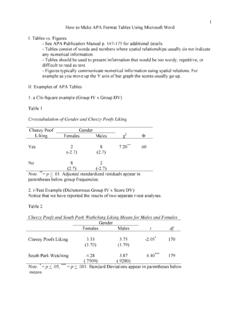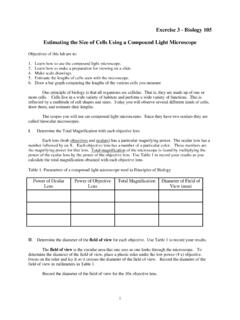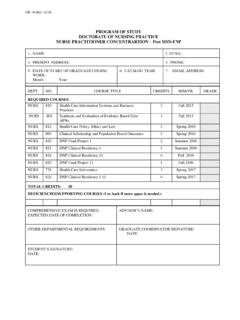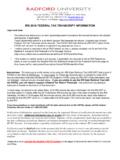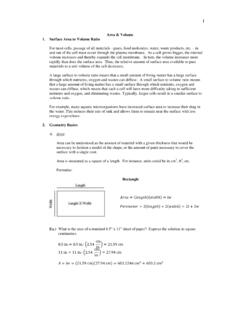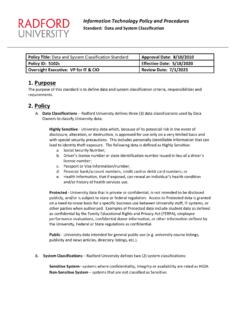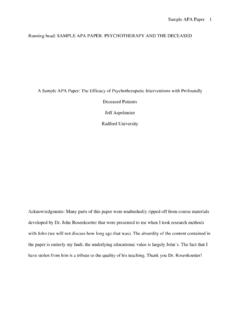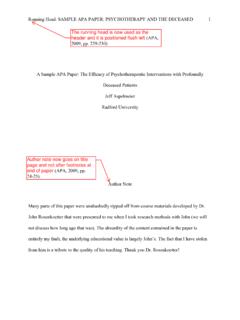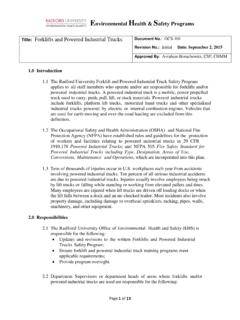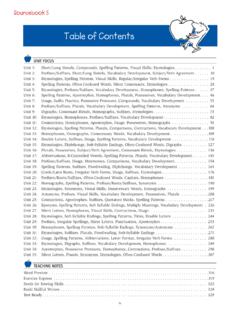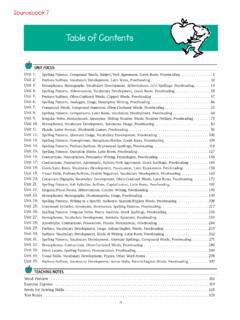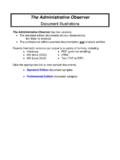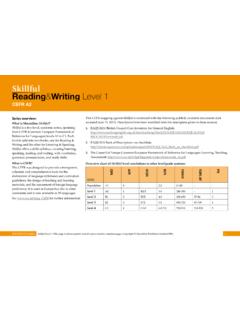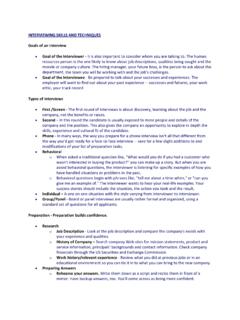Transcription of Ch. 2 Person Perception, Forming Impressions of Others
1 1Ch. 2 Person Perception, Forming Impressions of OthersI. Impression formation -The process through which we develop our beliefs and evaluations of other Solomon Asch (1946)- Viewed impression formation from a GestaltistPerspective. - Dominant Metaphor: People as Consistency Our perceptions of Others are more than the sum of information (Traits) we know about Others . - Individual Traits are evaluated in relation to other known Traits, and develop an overall picture where all the traits fit together formation Demo- You have been randomly assigned to 4 groups based on your Codename. Write you number on your data sheet- 1 Group at a time you will be shown briefly a set of traits describing a After reading the traits please rate them on a a scale from 1 to 7 (1 = negative, 7 = positive) for each of the 6 dimensions listed on your data sheet.
2 Generosity, Good-naturedness, Popularity, Happiness, Sociability, and Altruism - When it is not your turn, keep your eyes closed and please don t 1 Intelligent SkillfulIndustriousWarmDeterminedPractic alCautiousPlease rate the Person Now3 Group 2 Intelligent SkillfulIndustriousCold DeterminedPracticalCautiousPlease rate the Person NowGroup 3 Intelligent SkillfulIndustriousPolite DeterminedPracticalCautiousPlease rate the Person Now4 Group 4 Intelligent SkillfulIndustriousBlunt DeterminedPracticalCautiousPlease rate the Person NowResults# Below 4# Above 4 Group 1 Warm19 Group 2 Cold80 Group 3 Polite57 Group 4 Blunt76 Class data from 1/25/065A. Asch Central vs. Peripheral Traits-Central traits are have a stronger impact on our Impressions than Peripheral vs.
3 Cold is more central than Polite vs. Blunt-The StudyParticipants were given a set of traits describing a new Person . The list included either Warm, Cold, Polite, or Blunt List = Intelligent, skillful , Industrious, X, Determined, Practical, Cautious- Participants rated the Generosity, Happiness, good-naturedness, sociability, popularity, and altruism (among Others ) of the new formation Class Polite-bc Blunt-abAverage6 WarmColdPoliteBlunt020406080100 GenerousHappyGood-NaturedSociablePopular AltruisticAsch 1946-Warm Condition rated high on these traits- Cold Condition rated low on these The discrepancy in rating between the Polite vs. Blunt ratings was much Harold Kelly (1950) - replicated these results, and found that central traits not only affect not only our ratings of Others , but also influences our behavior.
4 (described in book p. 36)7B. Impression formation as Cognitive Algebra- Based on the notion that people are rational Additive vs. Averaged Impressions - Is our impression of an individual based on the sum of the values of known traits (Additive) or is it based on an average (sum of value of the traits divided by the number of known traits).Implications- if additive, Including your weakly positive traits along with strongly positive traits = more positive , Kind (+1) + Intelligent (+1) + Loyal (+1) = +3 Kind (+1) + Intelligent (+1) + Loyal (+1) + Organized (+.5) = + it is averagedIncluding weakly positive traits reduces your overall evaluation. , Kind (+1) + Intelligent (+1) + Loyal (+1) / 3 = +1 Kind (+1) + Intelligent (+1) + Loyal (+1) + Organized (+.)
5 5) / 4 = +.875- Research supports the Averaging Model (A Weighted Averaging Model).82. Negativity Bias - Negative traits affect our Impressions more than positive Negative traits are given stronger weighting than positive Evaluations of a Person described as having a strongly positive trait and strongly negative trait are not viewed neutrally. Rather they are viewed as rather Averaging predictsIntelligent (+1) + Cold (-1) / 2 = 0- Weighted Average predictsIntelligent (+1 x 1) + Cold (-1 x 2) / 3 = Positivity Bias - Generally we evaluate people we know Result of averaging across a large body of information- Most of our social interactions are positive (due to situational norms).- We self limit our interactions; avoid interactions with negative When we expect positive interactions with people we tend to attend to positive behaviors and traits, and remember these positive aspects Attribution TheoryA.
6 Definitions1. Attribution = the inferences we make about the causes of other peoples behavior2. Types of potential causesa. Internal = the Person caused the behavior- Dispositional Behavior reflects personalityLikely to happen again- Intentional Behavior was chosen- Unintentional Behavior was not chosen ( , accidental) b. External = the situation caused the behaviorB. Kelly s Covariation Model-The attribution process = search forinformation about what a behavior co-occurs (covaries) with:a. Beh. Co-occurs with the Situation = External Attributionb. Beh. Co-occurs with the the Person = Internal Attribution- Dominating Metaphor: Views people as Naive Scientists - analyze the world in a rational manner101. Covariation Informationa) Consensus Information: Do other people behave this way in this situation?
7 B) Consistency Information: Is the Person s behavior consistent across time in this situation?c) Distinctiveness Information: Is the Person s behavior unique to this situation?1. Covariation Informatin Consensus, Low Distinctiveness, and High Consistency = Internal AttributionsHigh Consensus, High Distinctiveness, and High Consistency= External (Situational) Attributions112. Person x Situation ExamplesBeh = Cursing Situation- = no cursingClassPlaySpace+= cursingRoomGroundShipd1 d2d1 d2d1 d2 Stan------Kyle------Cartman+ ++ ++ +- Low Consensus, Low Distinctiveness, High Consistency2. Person x Situation ExamplesBeh = Cursing Situation- = no cursingClassPlaySpace+= cursingRoomGroundShipd1 d2d1 d2d1 d2 Stan----+ +Kyle----+ +Cartman----+ +- High Consensus, High Distinctiveness, High Consistency123.
8 Final Comments- When any of these is missing, we are less confident about making internal This process will help identify what is internal (caused by the Person ), but it does not tell us what internal factors caused the behavior. (Dispositions vs. Other motives)C. Theory of Correspondent Inference (Jones and Davis)- Attempts to explain how we can use an individual s behavior to infer information about their personality (a correspondent inference) and rule out behaviors that are not reflective of one s personality (a non-correspondent inference).13C. Theory of Correspondent Inference (Jones and Davis)-Correspondent Inference= behavior reflects dispositions and intentions- Behavior corresponds with intentions-Noncorrespondent Inference= behaviors are unintentional or external1.
9 Correspondence Informationa) Whether or not behaviors are Freely Chosen(or intended):- Based on Knowledge and Ability- Did you knowingly do it (or reasonably know what the outcome would be)- Did you have the ability to do it (or prevent it).- , are the video taped confessions of hostages, believable?141. Correspondence Information2) Motives with Noncommon Effects:Outcomes that only have one likely cause (motive / behavior) are very diagnostic (Jones & Davis)When there are multiple likely causes for the behavior then we become less Pleads Guilty; we agree- Few likely causes besides guiltAccused Pleads Innocent; we don t know what to May plead innocent because they are innocent- May plead innocent to avoid punishment1. Correspondence Information3) Socially Desirability of Behavior- Behavior low in social desirability is more diagnostic than highly socially desirable This is really an extension of the analysis of noncommon Social desirability serves as another potential cause for Beh.
10 = Mr. X kicks your dog- Infer the Mr. X is a dog hating jerk- Beh. = Mr. X pets your dog- Mr. X may or may not really like dogs. 151. Correspondence Information- Freely chosen behavior + non common effects + not clearly socially desirable = tells us about an individual s personality (correspondent inference).- if any of these is missing, we will be less certain about our judgments and more likely to make noncorrespondent attributions for behavior
